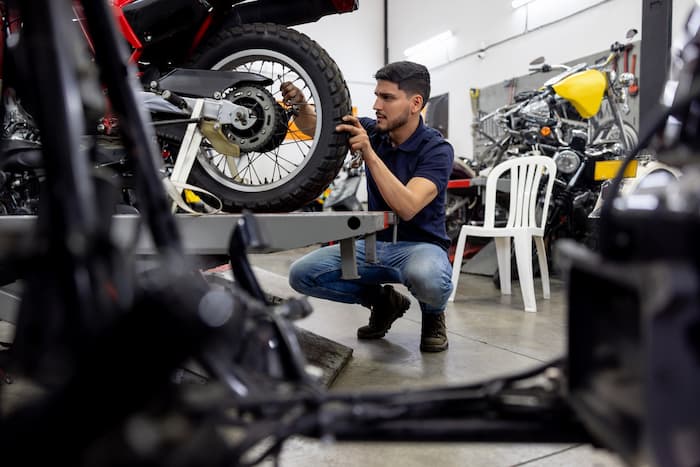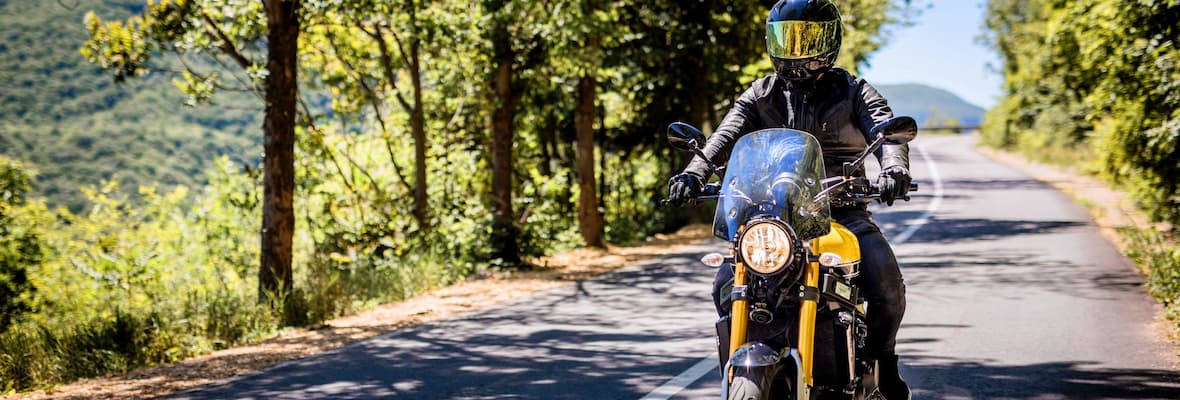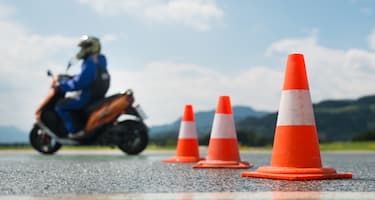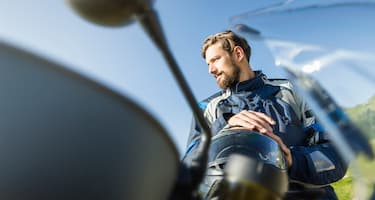Whether you’re buying your first motorcycle or investing in a brand-new bike, you’ll want to know the costs. Motorcycle running costs can add up, and you may find yourself paying for hidden costs.
And if you’re looking to ditch your car for a motorcycle, there are a few things you should consider first. Not only will you be paying for the bike, but also safety gear, licence and registration fees, maintenance, repairs, fuel and your motorcycle insurance policy.
Here are the costs you’ll need to know before investing in a motorcycle.
Motorcycle Costs
There are two types of costs to consider with any motorcycle purchase. They are your one-time costs and your ongoing costs.
One-time costs usually include the bike itself, safety gear, tools, financing and depreciation.
Ongoing costs can include your insurance, vehicle licence and expenses based on your rides including fuel, tyres and maintenance.
Types of Motorcycles
The largest up-front cost is likely to be the motorcycle itself. Motorcycle prices can vary, and (learner-approved) motorcycles can range from $3,000-$8,000 on the lower end, $8,000-$15,000 in the middle and $15,000-$20,000 on the upper end. [1]
If you're looking for a second-hand bike, models can start from $1,000-$5,000 on the lower end and go to $5,000-$10,000 on the upper end. Some second-hand models can also be priced above $10,000 but this would depend on the type of motorcycle being sold. [1]
However, if you’re looking for a model that is very popular or has a lot of horsepower, prices can sit in the $20,000–$50,000 range. While some specialty bikes can range up to $50,000+ and collectors bikes up to more than $100,000.
Safety Gear

Unlike all the included safety features you get with car airbags and seatbelts, when choosing a motorcycle, you should ensure your safety by dressing head-to-toe in protective clothing.
Safety gear must-haves for riders include a helmet, gloves, jacket, riding pants, and boots. You could spend anywhere from $400-$3,500 on new riding gear. [2]
Each item provides a layer of protection when riding your motorcycle.
Helmets are one of the most important pieces of safety gear and can cost anywhere from $100–$1,200 [2]. When you choose a motorcycle helmet, prices will vary based on the helmet's material and level of protection.
You can invest in a Kevlar-reinforced motor jacket with high-abrasion-grade leather. When you purchase a motorcycle jacket you can pay anywhere from $150-$1,000. [2]
Motorcycle gloves can cost between $25-$500 while boots can cost anywhere from $100-$800 [2]. All the costs of these items are largely determined by the quality and level of protection provided.
Also, protective pants are highly encouraged, especially when you’re riding above 24 km/h.
Keep in mind that wear and tear from the wind, rain, dust, stones, and abrasions may mean that safety gear can change from a one-time cost to an ongoing cost over time.
Licence and Registration Fees
You are required to get an Australian motorcycle licence and register your vehicle before you ride a motorcycle.
The cost of getting a motorbike licence varies from state to state. You must also be at least 16 years or older (except in Western Australia), need proof of identity and pass a driver's knowledge test.
In Australia, annual motorcycle registration costs may include administration costs, government fees and compulsory third-party insurance. Your total fee may also vary based on tare weight (the weight of a vehicle without the motorcycle riders), vehicle type and usage.
Motorcycle registration costs vary from state to state and are an ongoing cost that occurs annually.
Here's what you'll pay for in each state:
- ACT - Vehicle registration, road safety contribution, a rescue fee, a lifetime care and support levy and compulsory third-party insurance. [3]
- NSW - A flat registration fee, a flat rate vehicle tax for motorcycles and compulsory third-party insurance. [4]
- NT - A registration fee, an administration fee and compulsory third-party insurance. [5]
- Qld - A registration fee, a traffic improvement fee and compulsory third-party insurance. [6]
- SA - A registration fee, a lifetime support scheme fee, emergency services levy, goods and services tax, input tax credits and compulsory third-party insurance. [7]
- Tas - A registration fee, a motor tax and compulsory third-party insurance. [8]
- Vic - A registration fee, a motor vehicle duty fee, a number plate fee, a motorcycle safety fee and compulsory third-party insurance. [9]
- WA - The cost includes registration, an administration fee, a vehicle inspection fee, a licence duty fee, a transfer fee and compulsory third-party insurance. [10]
Repair Costs

You should book your motorcycle in for a service at least every 6-12 months and this is where unexpected costs may add up.
The type of motorcycle you own, your bike’s overall condition and how often you ride, will ultimately determine the cost of maintenance or repairs.
There are three different types of repairs, regular maintenance, minor services and major services.
Regular maintenance can include:
- Fixing leaks and drips
- Checking battery power
- Checking the brakes, filter and fluids
Minor services can include:
- Changing the oil and fluids
- Replacing head and tail lights
- Replacing chains, belts, spark plugs and electrical components
Major services can include:
- Changing the spark plugs
- Cleaning the air filters
- Adjusting the chains
- Flushing brake fluids
- Fitting tyres
- Replacing the engine, gearbox oil and filter
The more you ride your bike the more maintenance it’ll need over time. Getting regular services will ensure that your bike is reliable, manoeuvrable, and most importantly in a safe condition for you to ride.
Fuel

Motorcycles are known for being fuel-efficient, and with increasing interest in improving fuel consumption, it’s likely that more Australians are considering motorcycles than ever before.
In 2020, motorcycles consumed 6.1 litres per 100 kilometres in Australia. This was nearly half the rate of fuel consumption by passenger vehicles running at 11.1 litres per 100 kilometres. [11]
However, the cost of fuel is a major motorcycle running cost, especially if you're planning to use your motorcycle as your main mode of transport.
Motorcycle Insurance
Motorcycle insurance is an important motorcycle running cost.
Comprehensive Motorcycle Insurance covers accidental damage to your motorcycle, damage to other people's property and damage caused by fire, theft and attempted theft.
Legal liability cover (up to $20 million) is included in Budget Direct Comprehensive Motorcycle Insurance policies. Legal liability provides you with cover for accidental damage to someone else's property caused by your motorcycle, trailer or sidecar attached to your motorcycle.
This also includes optional cover for a hire car, riding gear cover, your choice of repairer and a reduced windshield excess.
Budget Direct Comprehensive Motorcycle Insurance provides the most amount of cover to ensure you and your motorcycle are best protected in case something goes wrong.
We also offer Third-Party Motorcycle Insurance with two levels of cover, Third Party Property Only cover and Third Party Property, Fire and Theft protection.
And if you're concerned about the cost of insurance and potential motorbike insurance claims then there are also ways to save on motorcycle insurance.
Compulsory Third Party Insurance
Compulsory third-party (CTP) insurance is attached to the registration of your vehicle and protects the rider that's responsible for the accident.
If you’re the rider who is deemed at fault in a motor accident, CTP can cover you against compensation claims made by people who were injured in the motorcycle accident.
Compulsory Third Party Insurance should not be mistaken for Third Party Motorcycle Insurance.
How to Reduce Costs
Buy Second-Hand
Looking for learner-approved second-hand bike models between $1,000-$5,000 is a great place to start. Similarly for your safety gear, you should aim to spend on the lower end starting at $400. [2]
In this case, safety gear includes a helmet, gloves, jacket, riding pants and boots.
Get Regular Services
Getting your motorcycle serviced every 6-12 months will help avoid any excessive repair costs. Regular maintenance will also ensure that your motorcycle is in good working condition and is safe for you to ride.
Alternatively, you can save on costs if you learn to do some motorcycle maintenance tasks at home, in between visits.
Stop Speeding to Save Fuel
Riding slower doesn’t mean you’ll waste fuel. Riding your motorcycle at a slower, more controlled pace will actually reduce fuel consumption, and if you do need to ride at a faster speed, accelerating gently will help you save on fuel.
Reduce Your Risk
By parking your motorcycle in a secure garage you are not only stopping your motorcycle from being stolen but you’re also likely to be reducing your premium.
If your motorcycle has security features (like a security alarm) make sure this is also added to your policy.
Save on Motorcycle Insurance
If you’re interested in saving on motorcycle insurance, then you’ll need to ensure that you’re only paying for the cover that you need.
Buy a new Budget Direct Motorcycle Insurance policy online and save 15%^ on your first year’s premium.




.jpg)

